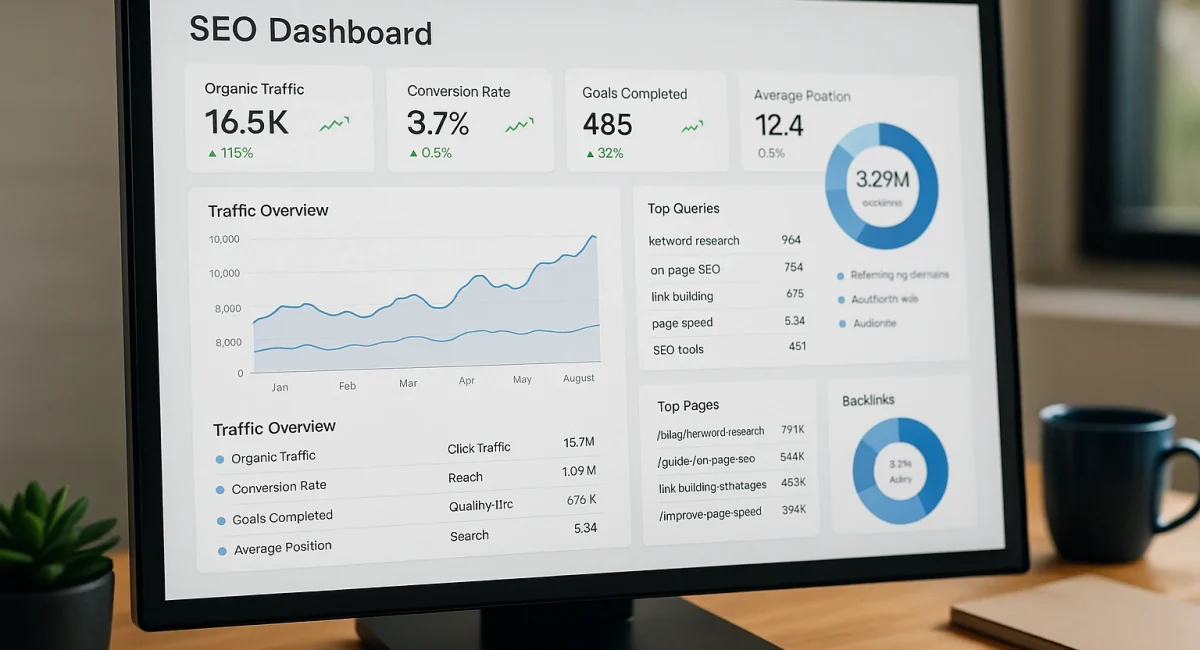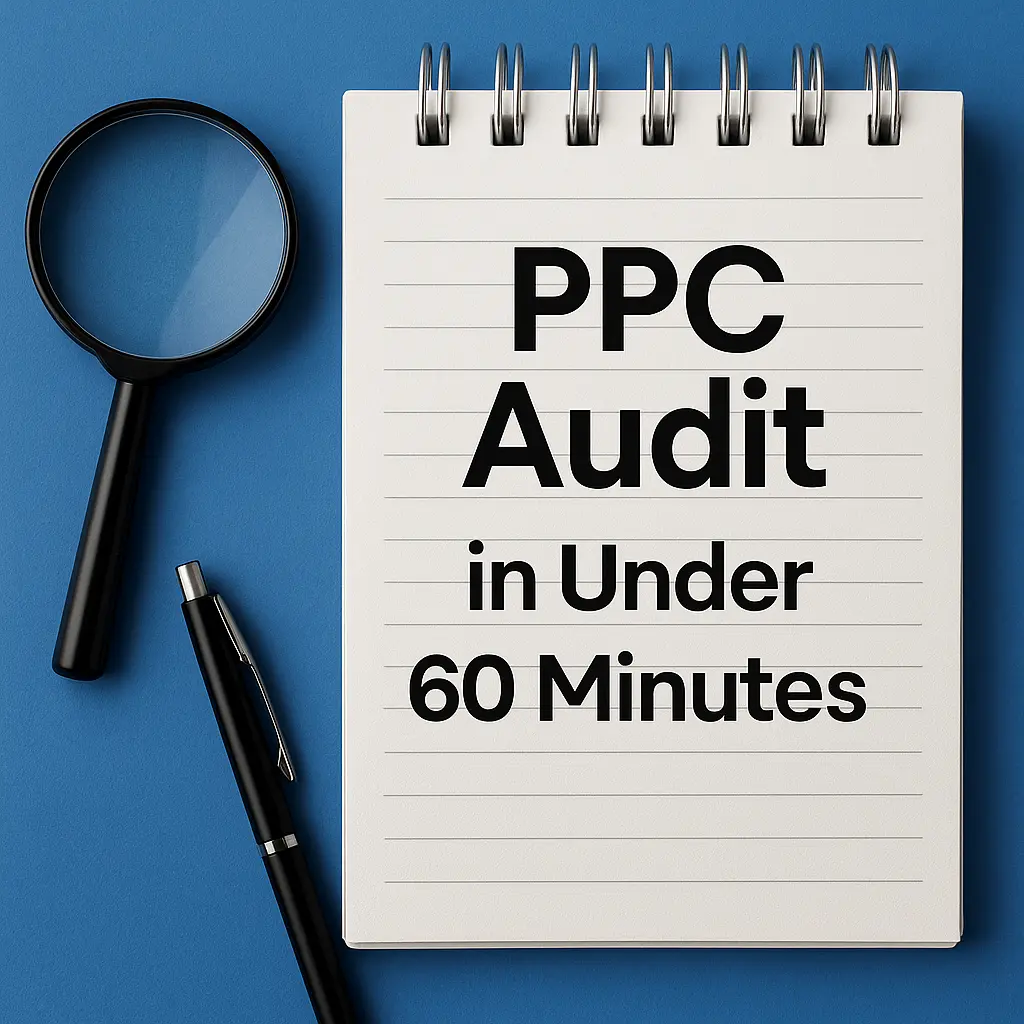Table of Contents
Introduction
Search Engine Optimization (SEO) is often seen as a long game, with results taking anywhere from six months to a year to materialize. For businesses and marketers under pressure to demonstrate quick returns on investment (ROI), this timeline can be frustrating. However, SEO doesn’t always have to be a slow grind. With the right approach, you can achieve fast SEO results that boost visibility and drive traffic in just a few weeks.
Enter the concept of SEO sprints—short, focused bursts of effort targeting high-impact areas of your website. These 2–4 week initiatives focus on quick wins, allowing you to see measurable gains without waiting months for organic growth. Whether it’s refining on-page optimization, refreshing outdated content, or fixing technical issues, SEO sprints can deliver immediate value while complementing long-term strategies.
In this article, we’ll explore how to implement SEO sprints effectively, the key areas to focus on for quick SEO wins, and actionable steps to ensure success. Let’s dive into how you can accelerate your SEO efforts and see results sooner rather than later.

What Are SEO Sprints?
SEO sprints are short, intensive periods of focused work aimed at improving specific aspects of a website’s search engine performance. Unlike traditional SEO strategies that span months or years, an SEO sprint typically lasts 2–4 weeks and targets areas that can yield fast results.
The core idea is to prioritize tasks that have a high impact on visibility and traffic with minimal time investment. This could involve optimizing title tags, fixing broken links, or refreshing underperforming content. By concentrating efforts on these quick-impact areas, you can generate measurable improvements without overhauling your entire site.
Characteristics of an SEO Sprint
- Time-Bound: Limited to a short timeframe, usually 2–4 weeks.
- Focused: Targets one or two specific areas, such as technical fixes or content updates.
- Measurable: Aims for clear, quantifiable outcomes like improved rankings or increased clicks.
- Agile: Allows for rapid testing and iteration based on results.
By adopting this approach, marketers can address immediate pain points while laying the groundwork for sustained growth. SEO sprints are particularly useful for businesses needing to demonstrate quick value or recover from sudden drops in traffic.
Why SEO Sprints Work
SEO sprints are effective because they focus on low-hanging fruit—issues or opportunities that can be addressed quickly to produce noticeable results. Traditional SEO often involves waiting for search engines to crawl and index broad changes, but sprints target areas where updates are reflected faster.
For instance, optimizing title tags or improving internal linking can lead to almost immediate improvements in click-through rates (CTR) and user engagement. Search engines like Google often prioritize sites that make user-centric updates, rewarding quick adjustments with better rankings or increased visibility in search results.
Benefits of SEO Sprints
- Speed: Results can often be seen within days or weeks, not months.
- Cost-Effective: Requires less long-term resource commitment compared to comprehensive SEO campaigns.
- Flexibility: Can be tailored to specific business goals, such as boosting a particular product page.
- Motivation: Quick wins boost team morale and stakeholder confidence in SEO efforts.
Ultimately, SEO sprints work because they align with how search engines operate today—prioritizing fresh, relevant, and user-friendly content over stale or outdated pages. By focusing on fast SEO results, you can build momentum for larger initiatives.
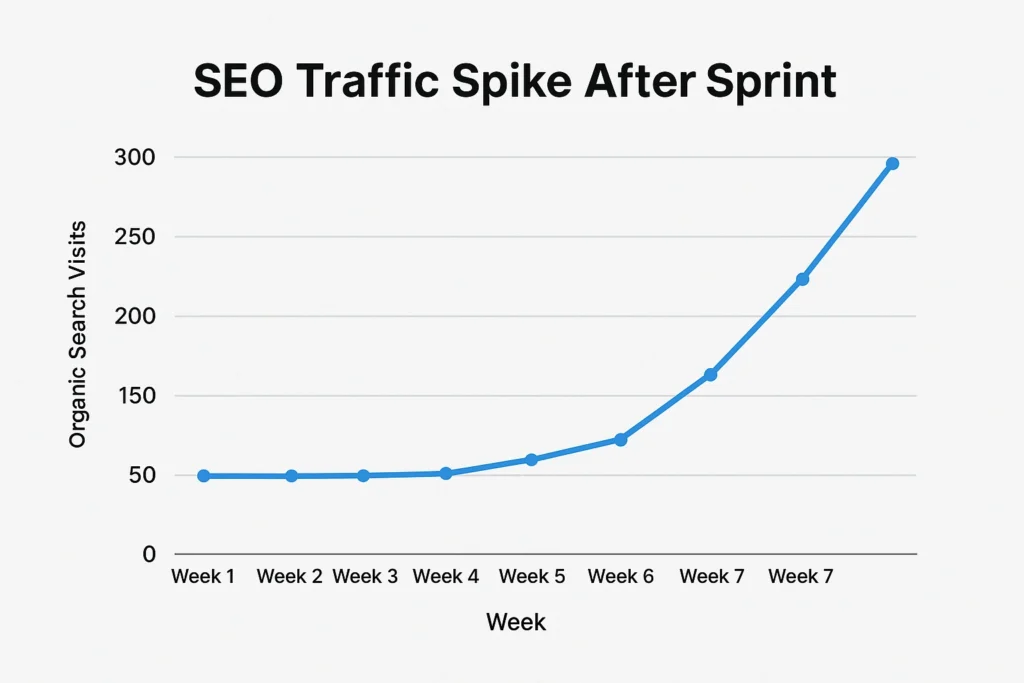
Key Areas for Quick SEO Wins
SEO sprints thrive on targeting specific website elements that can be optimized quickly for maximum impact. Below are some of the most effective areas to focus on during a sprint, each offering opportunities for rapid improvement.
1. Technical SEO Audits and Fixes
Technical SEO issues can drag down a site’s performance without being immediately obvious. Running a quick audit using tools like Google Search Console or Screaming Frog can uncover problems that are hurting your rankings.
Common fixes include:
- Resolving 404 and 500 errors.
- Improving site speed by compressing images or enabling caching.
- Fixing redirect loops or broken links.
These corrections often result in faster crawl rates and better user experiences, directly impacting your site’s visibility.
2. On-Page Optimization
On-page optimization is a goldmine for quick SEO wins. Small tweaks to elements like title tags, meta descriptions, and headers can significantly improve CTR and rankings.
Focus on:
- Writing compelling title tags with primary keywords (under 60 characters).
- Crafting unique meta descriptions that encourage clicks (under 160 characters).
- Ensuring proper use of H1-H6 tags for content structure.
Google often reflects these changes in search results within days, making this a high-priority task in any SEO sprint.
3. Internal Linking
Internal linking is an often-overlooked strategy that can boost page authority and improve user navigation. During a sprint, identify high-value pages (like cornerstone content) and link to them from relevant articles or pages.
Key actions:
- Add 3–5 internal links to important pages per post.
- Update anchor text to be descriptive and keyword-relevant.
- Fix broken internal links to ensure smooth navigation.
This not only helps search engines understand your site structure but also keeps users engaged longer, reducing bounce rates.
4. Content Refresh Strategy
Outdated or underperforming content can be a liability. A content refresh strategy involves updating existing pages to make them more relevant and valuable to users.
Steps for a content refresh:
- Identify pages with declining traffic using Google Analytics.
- Update statistics, facts, or examples to reflect current trends.
- Add new sections or visuals to enhance depth and engagement.
Refreshed content often regains traction quickly, especially if it already has some authority or backlinks. For more on content refreshes, check out Search Engine Journal’s guide.
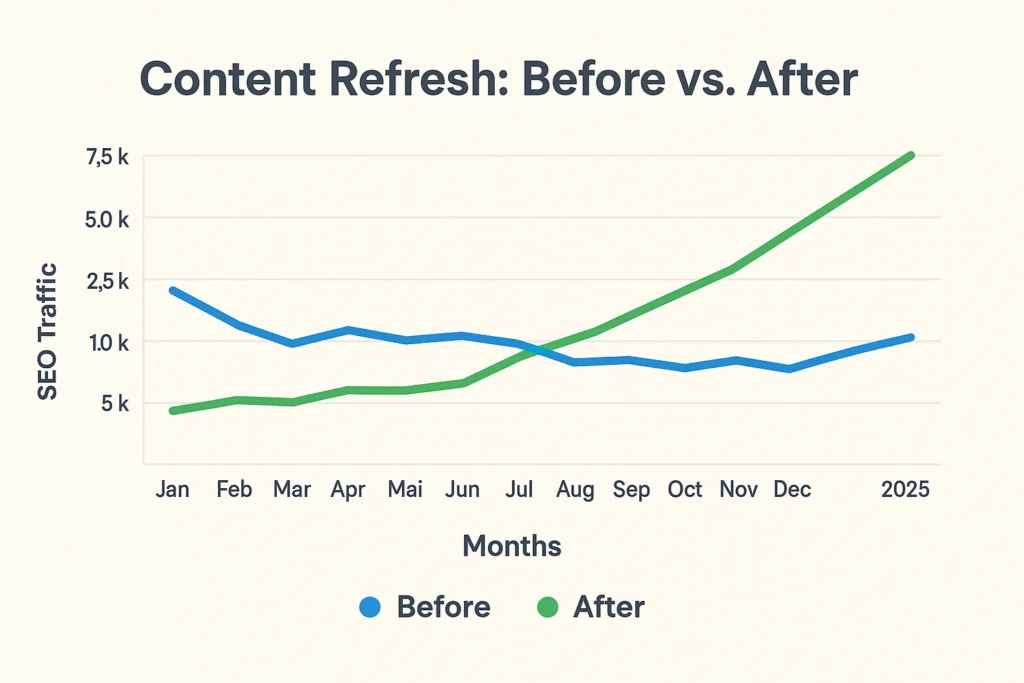
How to Run an Effective SEO Sprint
Running an SEO sprint requires careful planning to ensure you’re maximizing impact within a tight timeframe. Here’s a step-by-step guide to structure your sprint for success.
Step 1: Define Clear Objectives
Start by setting specific, measurable goals. Are you aiming to increase traffic by 10%? Improve rankings for a set of keywords? Defining your target ensures everyone is aligned on what “success” looks like.
Step 2: Conduct a Pre-Sprint Audit
Use tools like Ahrefs, SEMrush, or Google Search Console to identify issues and opportunities. Create a prioritized list of tasks based on impact and effort. Focus on areas like technical fixes or on-page optimization for quick returns.
Step 3: Assemble Your Team and Tools
Assign roles to your team members (e.g., content writer, technical SEO specialist) and ensure access to necessary tools. A typical toolkit might include:
| Tool | Purpose |
|---|---|
| Google Search Console | Track indexing issues and performance |
| Screaming Frog | Technical SEO audits |
| Ahrefs/SEMRush | Keyword and competitor analysis |
Step 4: Execute and Monitor Daily
Break tasks into daily or weekly goals. For instance, dedicate one week to on-page tweaks and another to internal linking. Monitor progress using real-time data from Google Analytics to make adjustments on the fly.
Step 5: Review and Document
At the end of the sprint, analyze results against your objectives. Document what worked, what didn’t, and lessons learned for future sprints. This iterative approach ensures continuous improvement.
Measuring Success After an SEO Sprint
Tracking the impact of your SEO sprint is crucial to understanding its value and refining future efforts. Focus on metrics that align with your goals and provide insight into short-term gains.
Key Metrics to Track
- Organic Traffic: Use Google Analytics to monitor increases in organic sessions.
- Keyword Rankings: Check ranking improvements for targeted terms using tools like Ahrefs or SEMrush.
- Click-Through Rates (CTR): Measure CTR changes in Google Search Console to assess on-page optimization impact.
- Bounce Rate: Monitor if users are staying longer on refreshed pages, indicating better engagement.
Beyond raw numbers, look for qualitative feedback. Are users finding your content more easily? Are stakeholders seeing the value in SEO? Combining data with observations paints a fuller picture of success.
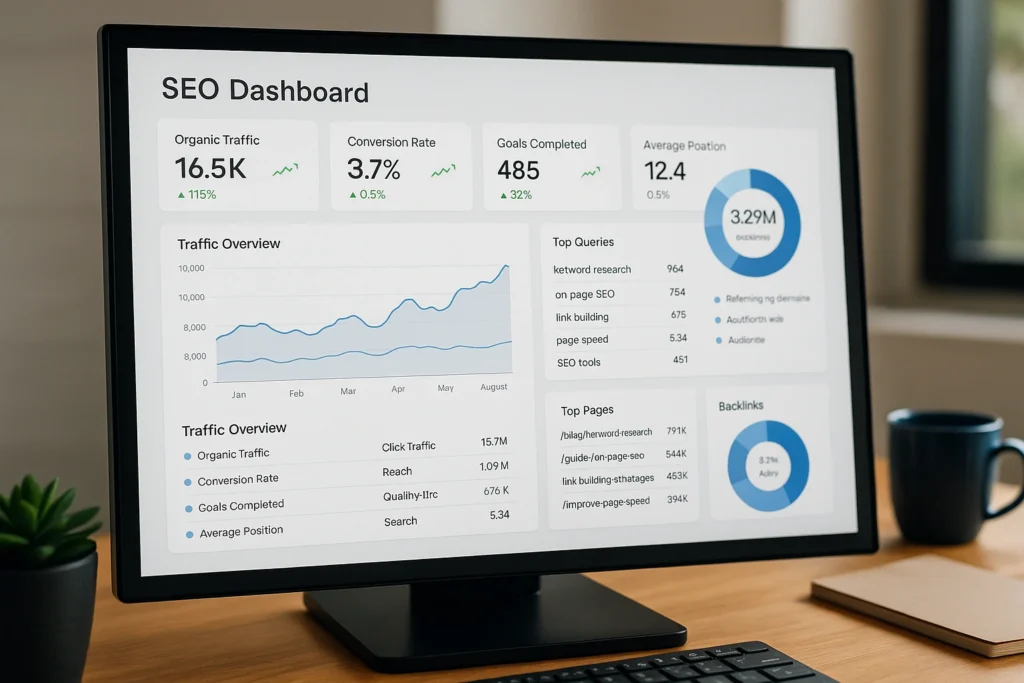
For a deeper dive into tracking SEO performance, refer to Google’s official guide on measuring SEO performance.
Common Pitfalls to Avoid
While SEO sprints can deliver impressive results, they’re not without challenges. Here are common mistakes to watch out for and how to avoid them.
1. Lack of Focus
Trying to tackle too many tasks in one sprint dilutes impact. Stick to 1–2 focus areas (e.g., technical fixes or content refresh) to maintain clarity and effectiveness.
2. Ignoring Data
Failing to base decisions on data can lead to wasted effort. Always start with an audit and let insights guide your priorities rather than guesswork.
3. Overlooking User Experience
SEO isn’t just about search engines; it’s about users. Ensure changes like updated meta descriptions or faster load times enhance the user journey, not just rankings.
4. Neglecting Post-Sprint Analysis
Skipping a post-sprint review means missing out on valuable insights. Always analyze results and document findings to improve future sprints.
By steering clear of these pitfalls, you can maximize the effectiveness of your efforts and ensure sustainable progress toward fast SEO results.
Conclusion
SEO doesn’t have to be a waiting game. With SEO sprints, marketers can achieve quick SEO wins by focusing on high-impact areas like on-page optimization, internal linking, and content refreshes. These short, targeted efforts—lasting just 2–4 weeks—can deliver measurable gains in traffic, rankings, and engagement, proving that SEO can offer rapid ROI when done right.
By following a structured approach, from setting clear goals to measuring outcomes, you can transform your website’s performance without the long-term commitment of traditional campaigns. Whether you’re addressing technical issues or revitalizing content with a smart content refresh strategy, the key is to prioritize tasks that yield immediate results while supporting broader goals.
Looking ahead, SEO sprints can be a powerful tool in an ever-evolving digital landscape. As search engines continue to prioritize user experience and fresh content, businesses that adopt agile, iterative approaches will stay ahead of the curve. So, why wait six months for results? Start planning your first SEO sprint today and watch your visibility soar.
Want to hear more how can SEO sprints help your company? Reach out to us here.
How soon can I expect to see results from an SEO sprint?
While results vary based on your website’s current status and the specific optimizations implemented, many businesses see initial improvements within 1-3 weeks after completing an SEO sprint. Technical fixes like resolving 404 errors or improving page speed can show results almost immediately, with Google often recrawling updated pages within days.
According to a 2023 study by Ahrefs, simple title tag optimizations produced ranking improvements for 58% of pages within two weeks. Content refreshes typically take slightly longer, with most sites seeing traffic increases 2-4 weeks after implementation.
It’s important to note that while some changes yield quick results, the full impact of your SEO sprint may continue to develop over 1-3 months as search engines fully process your optimizations and user signals accumulate.
What’s the ideal team size and composition for running an effective SEO sprint?
The ideal team size for an SEO sprint is typically 3-5 people, though this can vary based on your organization’s size and the sprint’s scope. What’s most important is having the right skill sets represented.
A well-rounded SEO sprint team usually includes:
- A project lead/SEO strategist to guide priorities and analyze results
- A technical SEO specialist to identify and implement fixes
- A content writer/editor to refresh or optimize content
- A web developer for implementing technical changes (as needed)
- A data analyst to measure performance (can be part-time)
According to a 2022 survey by Search Engine Journal, smaller teams of 3-4 specialists completed sprints 27% faster than larger teams while achieving similar results. The key is having dedicated time from each team member—most successful sprints allocate at least 50% of team members’ time during the sprint period rather than treating the sprint as a side project.
How much does an average SEO sprint cost in terms of time and resources?
The resource investment for an SEO sprint varies based on scope, but typically ranges from 40-100 person-hours spread across 2-4 weeks. For a medium-sized website (100-500 pages), a focused sprint might require:
- Planning and setup: 5-8 hours
- Technical audit and fixes: 10-30 hours
- Content optimization or refresh: 15-40 hours
- On-page element updates: 8-15 hours
- Analysis and reporting: 5-10 hours
In financial terms, organizations typically invest $3,000-$8,000 for an internal team sprint or $5,000-$12,000 if outsourcing to an agency, according to 2023 industry data from Backlinko.
The ROI can be substantial—a 2022 case study collection by Search Engine Land found that businesses implementing targeted SEO sprints saw an average of 22% increase in organic traffic value within 60 days, with some achieving up to 40% improvement in conversion rates from optimized pages.
Can SEO sprints work for all types of websites, including e-commerce and local businesses?
Yes, SEO sprints can be effective for virtually all website types, though the focus areas vary by business model. Each type of site has specific high-impact opportunities:
E-commerce Sites: SEO sprints for online stores often focus on product page optimization, schema markup implementation, and fixing duplicate content issues. According to a 2023 study by SEMrush, e-commerce sites that conducted targeted sprints saw an average 16% increase in product page visibility within 30 days.
Local Businesses: Local SEO sprints typically prioritize Google Business Profile optimization, local keyword insertion, and review management. Data from BrightLocal shows that 72% of local businesses implementing these focused sprints improved their Map Pack visibility within 45 days.
B2B/Service Sites: These websites benefit from sprints focused on conversion page optimization and thought leadership content refreshes. A HubSpot analysis found that B2B companies using sprint methodologies increased lead generation by 24% on average.
The key is tailoring your sprint to address the specific SEO factors that drive success in your industry and business model.
How do SEO sprints fit into a long-term SEO strategy?
SEO sprints complement rather than replace long-term SEO strategies. Think of sprints as tactical accelerators within your strategic framework.
In an effective SEO program, sprints typically serve these roles:
- Quick-win generators that deliver early results while longer strategies develop
- Problem solvers to address emerging issues or algorithm changes
- Testing grounds to validate approaches before wider implementation
- Momentum builders to energize teams and demonstrate SEO value to stakeholders
According to a 2023 survey by Conductor, organizations that integrate quarterly SEO sprints into their annual SEO roadmaps achieve 31% better year-over-year organic growth compared to those using only traditional approaches.
The ideal cadence is typically one 2-4 week sprint per quarter, with each focused on different aspects of your SEO. This allows you to maintain continuous improvement while still devoting resources to longer-term initiatives like authority building and content development.
What tools are essential for running an effective SEO sprint?
A well-equipped SEO sprint relies on a combination of analysis, implementation, and tracking tools. The essential toolkit includes:
Audit & Analysis Tools:
- Google Search Console – For identifying indexing issues and performance data (free)
- Screaming Frog SEO Spider – For technical audits ($149/year for premium version)
- Semrush or Ahrefs – For competitor and keyword analysis ($99-$399/month)
Implementation Tools:
- Google Tag Manager – For tracking implementation (free)
- Yoast SEO or Rank Math – For WordPress on-page optimization ($89-$199/year)
- PageSpeed Insights – For performance optimization (free)
Tracking & Reporting:
- Google Analytics 4 – For traffic and user behavior analysis (free)
- SERP tracking tools like AccuRanker or Wincher ($109-$199/month)
- Data visualization tools like Google Data Studio/Looker Studio (free)
According to a 2022 survey by Search Engine Journal, teams using integrated tool suites completed sprints 35% faster than those using disparate tools. Most professionals recommend budgeting $200-$500 monthly for essential SEO tools during active sprint periods.
What are the most common SEO sprint success stories and their actual results?
Several documented SEO sprint success stories demonstrate the potential of this approach:
Content Refresh Sprint: A SaaS company updated 25 underperforming blog posts during a 3-week sprint, focusing on adding current data, expanding thin sections, and improving keyword targeting. Results included a 78% increase in organic traffic to those pages within 45 days and 23 additional keyword rankings in the top 10 positions.
Technical SEO Sprint: An e-commerce retailer conducted a 2-week sprint focused solely on fixing core web vitals and mobile usability issues. Their mobile conversion rate improved by 27% within a month, and they saw an 18% reduction in bounce rate across product pages.
On-Page Optimization Sprint: A finance website spent 3 weeks optimizing title tags, meta descriptions, and H1s for their top 50 traffic-driving pages. They achieved a 32% increase in click-through rates and gained 4 featured snippets within 60 days.
Internal Linking Sprint: A travel blog implemented 320 new internal links during a 2-week sprint, focusing on elevating key destination guides. Their pages moved up an average of 5.7 positions for target keywords, and time on site increased by 14% due to better content discovery.
These results, documented in various case studies from 2021-2023, show that focused sprints consistently deliver meaningful improvements across different industries and SEO aspects.

